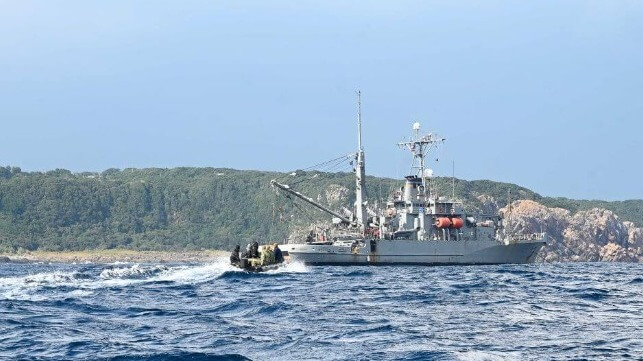Gearbox Failure, Pilot Error Caused V-22 Crash off Japan

A disintegrating metal gearbox was responsible for the crash of an Air Force CV-22 Osprey tilt-rotor aircraft off Japan last November, which killed eight servicemembers and prompted a large-scale subsea salvage response, according to the Air Force.
On the afternoon of November 29, the Japan Coast Guard received a call from a fisherman who reported that an aircraft was in trouble off the island of Yakushima. One of the aircraft's two engines appeared to be on fire, the good Samaritan reported. Five minutes after the call, the plane disappeared off tracking radar, prompting a SAR response.
The aircraft was a V-22 Osprey tiltrotor, transiting from Iwakuni to Kadena Air Base, Okinawa on a training flight with eight servicemembers on board. All members of the aircrew were killed in the accident; seven bodies were recovered in an exhaustive 43-day search. The U.S. Navy's salvage experts recovered key parts of the plane's wreckage, including its engines and rotor nacelles.
After the crash, the Pentagon issued a military-wide standdown to examine the safety of the Osprey, which had had serious mishaps before. The Air Force launched a major investigation to examine all aspects related to the crash, from human factors to materials to design and engineering. They assembled a sequence of events and determined a probable cause: gear box failure, aided by pilot error.
On the day of the casualty, the aircraft took off from Marine Corps Air Station Iwakuni, bound for Yakushima. About 40 minutes after takeoff, the cockpit warning panel flashed an alert for a chip detected in the left side proprotor gearbox. (This alert system monitors for metal chips in the gearbox lubricant oil, along with a burn-off system designed to eliminate loose chips.) About 30 seconds later, the alarm sounded again. The main pilot began looking for airfields to divert to on an electronic chart system in case they needed to land.
12 minutes later, the alarm sounded a third time, activating a "Land as Soon as Practical" guidance for safety. This protocol required the pilot to consider diverting to the nearest safe landing place, but did not require it. The nearest airfield was Kanoya Air Base, 10 miles behind them, but the main pilot did not discuss this option. Instead, he radioed the other aircraft in the formation and said that he planned to continue the mission route.
A fourth chip-detected alarm sounded five minutes later, and a fifth ten minutes after that. Shortly afterwards, the alarm sounded for a chip so large that it could not be burnt off. This triggered a more urgent land-quickly protocol, and the pilot diverted towards Yakushima, 11 minutes away. Multiple emergency landing possibilities were closer, but Yakushima was the only one in the aircrew's planning.
On arriving at Yakushima, air traffic control instructed the Osprey to wait for a commercial plane to clear the runway. After the other plane took off, the aircrew approached for a landing. Half a mile away from touching down, and 49 minutes after the first alarm, the left side gearbox failed catastrophically, immediately causing two left-hand uncontrolled barrel rolls and an 800-foot drop into the water.
After an extensive search and recovery operation, seven bodies were recovered, along with the wreckage of the aircraft. The gearbox was shipped to Marine Corps Air Station Cherry Point, where it was stripped down and examined. One pinion gear was shattered, and the bull gear's drive teeth were all stripped off, indicating that it had stopped transferring power to the prop. The gearbox was filled with large metal fragments.
The investigators found that the likely root cause was a "catastrophic failure of the left-hand prop rotor gear box," leading to a cascading drive system failure. This instantly cut off lift on the left hand proprotor while the right hand side remained at full power, sending the aircraft into an unrecoverable hard left roll.
They also faulted the aircrew for continuing the mission as planned for so long after alarms began to sound, and for failing to consider closer options than Yakushima. "The [crew] did not consider any other landing locations, such as islands with helipads, suitable landing terrain on other islands, or runways," the investigators found. "The [pilot's] decisions were casual, as they prolonged the mishap sequence and removed any consideration of an earlier landing."
The chief investigator also laid a share of the blame on the Osprey program office. "Inadequate action at the program level and inadequate coordination between the program office and the services prevented comprehensive awareness of [gearbox] risks, and substantially contributed to the mishap," wrote Lt. Gen. Michael E. Conley, head of Air Force Special Operations Command.
Additional documents obtained by the AP suggest that the pinion gear failed first, gradually shedding metal chips as it cracked and then ultimately broke apart. The supplemental documents indicated that there were multiple inclusions in the special metal alloy of the pinion gear, and while within acceptable size limits, any larger inclusions could have created opportunities for fatigue cracking.
AP also found that there had been at least 60 gearbox failures in the V-22 fleet over the past five years, including 41 involving chip warnings.
No comments:
Post a Comment